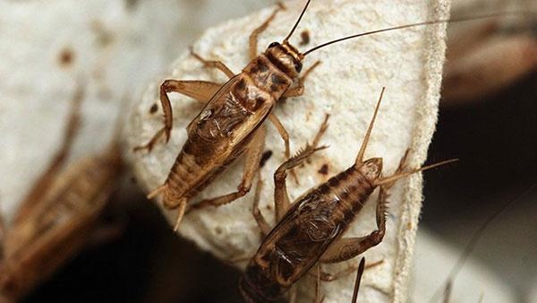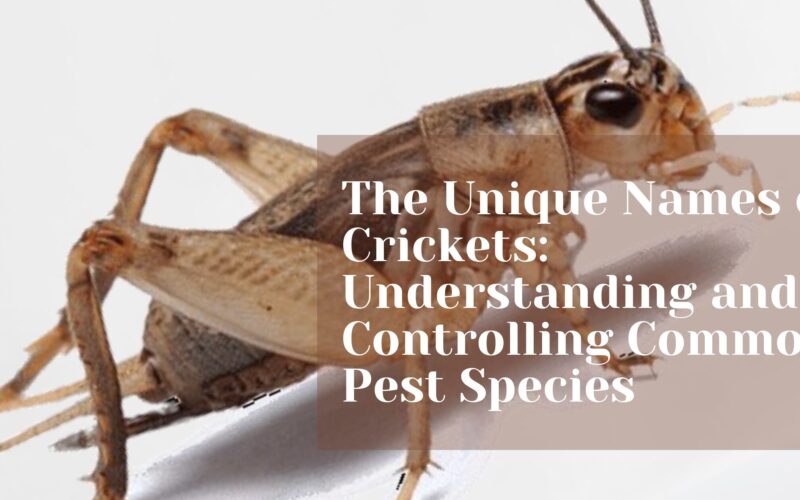Crickets are fascinating insect known for their distinctive chirping sounds and unique behaviors. While they play an important role in the ecosystem, serving as prey for many animals and aiding in the decomposition process, crickets can become a nuisance when they invade homes and gardens.
This blog post aims to help you identify and manage cricket infestations effectively. We will explore cricket characteristics, habits, signs of infestations, preventative measures, control methods, and when to seek professional help.
Cricket Characteristics and Habits
Crickets are part of the Gryllidae family, which includes a variety of species with unique characteristics. Generally, crickets have cylindrical bodies, round heads, and long antennae.
Their body color can range from light brown to dark brown or black, depending on the species. Here are some notable cricket types and their unique names:
Crickets come in various species, each with unique names that often reflect their physical characteristics, behavior, or habitat. Here are some of the unique names of crickets:
- Northern Mole Cricket (Neocurtilla hexadactyla): Known for its burrowing habits and found in northern regions.
- Southern Mole Cricket (Scapteriscus borellii): A burrowing cricket species common in southern regions.
- Tawny Mole Cricket (Neoscapteriscus vicinus): Another burrowing species, recognized by its tawny color.
- Restless Bush Cricket (Pholidoptera griseoaptera): Named for its active nature, often found in bushes and shrubs.
- Short-winged Bush Cricket (Decticus verrucivorus): Notable for its short wings and presence in bushy areas.
- Two-toothed Scaly Cricket (Eumodicogryllus bordigalensis): Characterized by its scaly exoskeleton and two prominent teeth.
- Slow Scaly Cricket (Loxoblemmus albipalpis): Known for its slow movements and scaly body.
- Eastern Ant Cricket (Gryllomorpha antoni): Often found in association with ants.
- Ground Crickets: A general category with species adapted to living on the ground.
- Tree Crickets: Species that live in trees and are recognized for their musical chirping.
Crickets are primarily nocturnal, which means they are most active at night. They are well-known for their chirping sounds, which males produce by rubbing their wings together to attract females. This chirping can become quite loud and persistent, especially if crickets find their way indoors.
Crickets prefer moist environments, which makes gardens, lawns, and basements ideal habitats. They feed on a variety of organic materials, including plants, fabrics, and even other insects. When they infest homes, they can cause damage to fabrics, paper, and other materials.
Identifying Cricket Infestations

To effectively control cricket populations, it’s essential to recognize the signs of an infestation early. Here are some common indicators:
- Chirping Sounds: The most obvious sign of a cricket infestation is the characteristic chirping sound, particularly at night. If you hear persistent chirping, especially in specific areas of your home or garden, it is a clear sign that crickets are present.
- Visible Damage: Crickets can cause noticeable damage to plants, fabrics, and other materials. Look for chewed leaves in your garden or holes in fabric items like curtains and clothes.
- Droppings: Cricket droppings are small, black, and pellet-like. Finding these droppings in areas where crickets are active can confirm their presence.
- Sightings: Seeing crickets in your home or garden, especially during the day, is a sign of a significant infestation. Crickets are usually nocturnal, so daytime sightings indicate a larger population.
Common areas to check for crickets include basements, kitchens, bathrooms, gardens, and lawns. Crickets are attracted to moist, dark places, so pay extra attention to these areas.
Preventative Measures
Preventing crickets from becoming a problem in your home or garden involves regular maintenance and vigilance. Here are some effective preventative measures:
1. Regular Lawn and Garden Maintenance
Maintaining a healthy outdoor environment is crucial in preventing crickets from becoming a problem. Here are some tips:
- Keep Your Lawn Well-Trimmed: Regularly mowing your lawn helps to keep the grass short and reduces the number of hiding places for crickets. Overgrown grass can provide an ideal habitat for these pests.
- Remove Debris: Remove leaves, grass clippings, and other debris from your lawn and garden. Crickets use these materials for shelter, so keeping your outdoor space clean can discourage them from settling.
- Water Wisely: Avoid overwatering your lawn and garden. Crickets prefer moist environments, so watering your lawn early in the morning can allow it to dry out during the day, making it less attractive to crickets.
2. Sealing Entry Points
Preventing crickets from entering your home is a critical step in controlling infestations. Here are some tips:
- Inspect Your Home: Regularly inspect your home for cracks and gaps around windows, doors, and the foundation. Pay attention to areas where utilities enter your home, as these can be common entry points for crickets.
- Seal Cracks and Gaps: Use caulk or weatherstripping to seal cracks and gaps around windows and doors. This not only prevents crickets from entering but also helps to improve your home’s energy efficiency.
- Install Door Sweeps: Install door sweeps on exterior doors to prevent crickets from entering through the gap at the bottom. Ensure that door sweeps are in good condition and replace them if they are worn out.
- Repair Screens: Repair or replace damaged window and door screens to keep crickets out. Crickets can easily enter through small tears or holes in screens.
3. Reducing Moisture
Crickets are attracted to moist environments, so reducing moisture in and around your home can make it less inviting to these pests. Here are some tips:
- Fix Leaks: Repair any leaks in your plumbing, roof, and foundation to prevent moisture buildup. Even small leaks can create a hospitable environment for crickets.
- Use Dehumidifiers: Use dehumidifiers in damp areas of your home, such as basements and crawl spaces, to reduce humidity levels. Keeping these areas dry can discourage crickets from settling.
- Improve Ventilation: Ensure that your home is well-ventilated to reduce moisture buildup. Use exhaust fans in kitchens and bathrooms to remove excess moisture from cooking and bathing.
Effective Cricket Control Methods

If crickets have already invaded your home or garden, several control methods can help you manage and reduce their populations. Here are some effective strategies:
1. Insecticides
Insecticides can be an effective way to control cricket populations in and around your home. Here are some tips for using insecticides:
- Choose the Right Insecticide: Select an insecticide that is specifically formulated for crickets. Look for products that contain active ingredients like permethrin or bifenthrin, which are effective against crickets.
- Apply Around the Perimeter: Apply insecticide around the perimeter of your home to create a barrier that crickets cannot cross. Pay special attention to entry points like doors and windows.
- Target Active Areas: Apply insecticide in areas where crickets are active, such as basements, garages, and gardens. Follow the manufacturer’s instructions for application rates and safety precautions.
- Use Indoor-Safe Insecticides: If crickets have entered your home, use insecticides that are safe for indoor use. Look for products that are labeled for indoor use and follow the instructions carefully.
2. Natural Predators and Biological Control
Encouraging natural predators and using biological control agents can help manage cricket populations without relying on chemical insecticides. Here are some tips:
- Encourage Natural Predators: Birds, spiders, and other insects are natural predators of crickets. Creating a garden environment that attracts these predators can help keep cricket populations in check. For example, planting native plants and providing bird feeders can attract birds to your garden.
- Use Biological Control Agents: Biological control agents, such as nematodes, can be used to target cricket larvae in the soil. These beneficial organisms are safe for humans and pets and can effectively reduce cricket populations.
3. Traps and Baits
Using traps and baits can help reduce cricket populations by capturing and killing them. Here are some tips:
- Commercial Traps: Use commercially available cricket traps that contain attractants to lure crickets. Place these traps in areas where crickets are active, such as basements, garages, and gardens.
- DIY Traps: Create your own cricket traps using sticky tape or glue boards. Place these traps in areas where crickets are likely to travel.
- Baits: Use cricket baits that contain insecticides to attract and kill crickets. Place baits in strategic locations where crickets are active, but ensure they are out of reach of pets and children.
Dealing with Indoor Cricket Infestations
If crickets have made their way into your home, immediate action is necessary to manage the infestation and prevent further damage. Here are some steps to take:
1. Immediate Actions
- Vacuuming and Cleaning: Vacuum areas where crickets are active to remove them and their droppings. Be sure to dispose of the vacuum bag immediately to prevent crickets from escaping.
- Using Indoor-Safe Insecticides: Apply insecticides that are safe for indoor use in areas where crickets are active. Follow the manufacturer’s instructions for application rates and safety precautions.
2. Long-Term Solutions
- Maintaining Indoor Cleanliness: Keep your home clean and free of debris that can attract crickets. Regularly vacuum and clean areas where crickets are likely to hide, such as basements, kitchens, and bathrooms.
- Regularly Inspecting and Sealing Entry Points: Continue to inspect your home for cracks and gaps and seal any entry points to prevent crickets from entering. Regular maintenance can help keep crickets out of your home.
Professional Pest Control Services
In some cases, a cricket infestation may be too severe to handle on your own. When DIY methods are not enough, it may be time to consider professional pest control services. Here are some tips for seeking professional help:
1. When to Consider Professional Help
- Severe Infestations: If you have a large number of crickets in your home or garden, professional pest control services may be necessary to manage the infestation effectively.
- Recurring Infestations: If crickets keep returning despite your efforts to control them, a professional pest control service can help identify and address the underlying causes.
- Extensive Damage: If crickets have caused significant damage to your home or garden, professional pest control services can help prevent further damage and implement effective control measures.
2. Choosing a Pest Control Service
When choosing a pest control service, consider the following:
- Reputation: Look for a pest control service with a good reputation and positive reviews from customers.
- Experience: Choose a pest control service with experience in handling cricket infestations.
- Licensing and Certification: Ensure that the pest control service is licensed and certified to perform pest control services in your area.
- Eco-Friendly Options: Ask if the pest control service offers eco-friendly or integrated pest management (IPM) options to minimize the use of chemical insecticides.
Conclusion
The world of crickets is as diverse as it is fascinating. From the burrowing Mole Crickets to the chirping Tree Crickets, each species has a unique name that reflects its characteristics and behaviors.
Understanding these names helps us appreciate the rich diversity and ecological significance of these remarkable insects.However, when crickets become pests, it’s essential to take action to control their populations and prevent damage to your home and garden.
By following the preventative measures and control methods outlined in this blog post, you can effectively manage cricket infestations and enjoy a cricket-free environment. If necessary, don’t hesitate to seek professional pest control services to address severe or recurring infestations.
Read more on “The World of Crickets: 8 Types to Look Out For” to find out more information about crickets’ types.
